This piece first ran on Comixology.
_________________
No western comic has better sound effects than Art Baltazar and Franco’s kiddie superhero title Tiny Titans.
As you’d expect, the comic has lots of standard issue sound effects. The Batmobile goes
Beast Boy changing into a dog goes
Streaky the Super-Cat’s stomach goes
And so forth.
But Baltazar and Franco also make extensive use of less familiar sound effects. So when Robin presses, slides, and jumps, it goes:
Or when Raven reaches, it goes:
Manga pioneered the use of this sort of effect; a sound that isn’t so much a sound as a stage direction. Baltazar and Franco have made the technique a central part of their world, and it’s one of the consistent joys of reading their comics. Part of the fun is the child-like logic of the thing. Of course, if you reach it sounds like “reach”. Of course, if Killer Croc is rustling through the garbage, it will sound like:
The sound effects are also used to emphasize or escalate jokes. For example:
The first two panels use appropriate sound effects; “Shake Shake,” for the cereal, “Pour!” for the milk. But then things begin to go awry…and the sound effects emphasize the goofiness. The ice in the cereal bowl is so wrong it goes “Ice!” the carrot is so incongruous in its carrotness that it has to scream “Carrot!” And the sound effects get the final punchline too. Poor Robin is slapped not only with the image of the fish, but with the word (“Fish!”) as well.
The sound effects do more than just add humor though. You can see this by looking again at that page above, especially at the first couple of panels. If you think about it for a second, you’ll realize that the first two panels aren’t actually traditional sound effects either. They’re not nouns (“Fish!”) but they’re not onomatopoeia either. Instead, (like Raven’s “reach”) they’re verbs. They label the action.
In comics, of course, there isn’t actually any action; no one moves. Usually, motion is conveyed through motion lines (as in the last panel, with the penguin slapping down the fish) or through the sense of time passing from panel to panel. Here, though, the motion is also created by the sound effects. They’re the analog to those clunky text boxes which would tell you that Spider-Man raced across the city, except that the text boxes have been streamlined and incorporated into the picture. The still image isn’t only an image; it’s also a word. And words come off the page; they go in at your eye and wander around your brain and come out as an idea. Which means that if an image is also a word, the image moves.
For Tiny Titans, then, sound effects end up as a substitute for animation. This fits naturally into artist (and letterer) Baltazar’s overall style. Tiny Titans, with its thick outlines, and simple figures, looks in some ways like an animated cartoon. Yet, at the same time, it’s unambiguously illustrational — much more so than a lot of slick, anonymous mainstream superhero art for adults. In the picture below, for example:
You can see Balthazar’s hand in the way the door curves out of true, or the slanting lines of the floor and doorjamb at impossible angles to each other, or in the bat’s delightfully wobbling motion line. It’s a drawing that’s not afraid of its drawingness. The charm is in the imperfection.
Similarly, Balthazar’s sound effects draw attention to themselves; they’re story-telling devices, and so they point to the storyteller. Again, the images are energized, or moved, not just by sequence, but by something like language — a conspiracy that goes back and forth between creator and reader. It’s a picture of a story, or a story of a picture. Which, for kids or adults, is hard to resist. Especially with bunnies.

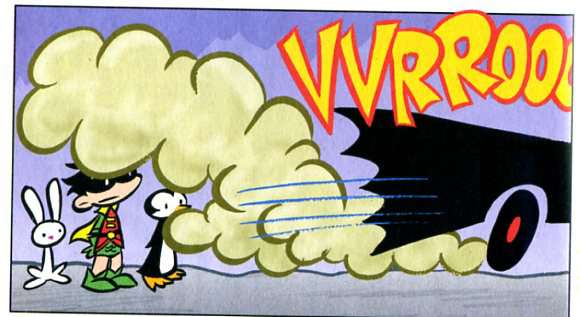
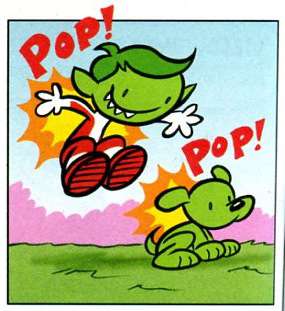
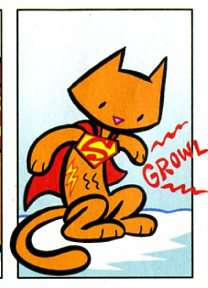
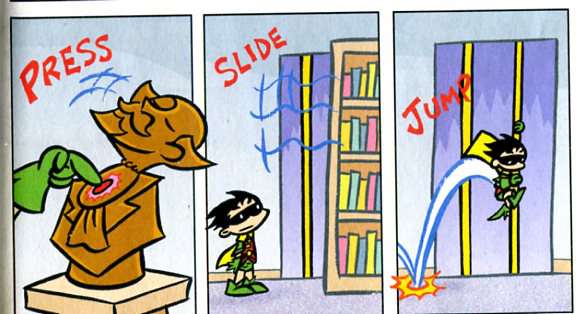

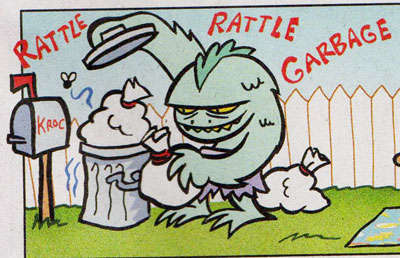

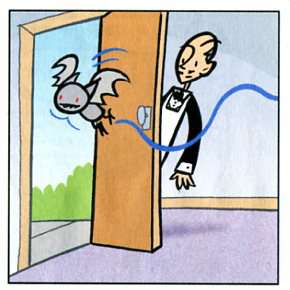
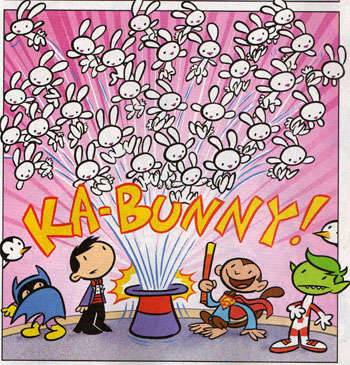
“Manga pioneered the use of this sort of effect; a sound that isn’t so much a sound as a stage direction.”
It did? Citation please.
Thanks for this post. This the stuff that more critical looks at comics could stand to linger on.
On a related subject, I was reading Lynn Johnston’s account of how sound effects were essentially her favorite thing to write/draw. If you look at some of her For Better or For Worse Sunday pages, there’s a playful, rhythmic quality to her sound-drawings. Not diagrammed sound like in Megan Kelso’s stories or that short story from Nick Bertozzi, but traditionally-rendered-written-sound used as a propulsive element in the stories.
I actually understood all of For Better or For Worse because of that.
No citation, Derik; I just sort of assumed it was common knowledge, because I am half-assed like that. Manga does use it all the time though; there’s all sorts of unusual sound effects (“Silence”), and they’re much more prevalent than in american comics. I’m reasonably certain that’s where Balthazar and Franco got it too; they’re work looks like they’ve seen some manga, certainly.
And glad you liked it Darryl!
One of the reasons I bristle when, in the course of discussing the return of original art, the letterer is never mentioned.
Being a 1960s Marvel Zombie, I always felt that Artie Simek’s and Sam Rosen’s lettering, sound effects and logos were a CRUCIAL part of Marvel’s visual brand. As a matter of fact, sound effects often put the “pop” in Pop Art. So, in my opinion, since the letterers were such an important part of the final visuals of a Silver Age-era originals, those letterers should have also been given a piece of the original art pie.
For that same reason, I think Wally Wood’s “Mad” spoof “Sound Effects” should be mandatory viewing for any comics aficionado, as are the splash pages for most “Spirit” newspaper comic strip sections.
And to show I practice what I preach, here are some examples of my art where the lettering is an integral part of the overall visuals of the page:
http://home.comcast.net/~russ.maheras/tet-frags-104-72dpi.jpg
http://home.comcast.net/~russ.maheras/Secret-TM-Maple1-72dpi.jpg
I loved the art of late 1960s and 1970s fan artist Alan James “Jim” Hanley because he took a page from Walt Kelly’s portfolio by giving his lettering personality. Hanley took it a step further, I think, by actually working the sound effects into the art itself. Here are a couple of examples:
http://home.comcast.net/~russ.maheras/Hanley-TBG-0251-72dpi.jpg
http://home.comcast.net/~russ.maheras/Hanley-1974-Maelstrom-02-NSM-01-72dpi.jpg
Need I say that I find the somewhat sterile computerized lettering today awkward and artificial?
Noah: I was curious about the “pioneered” aspect.
On this auction site you can view the entire story “Sound Effects” in the form of a sharp slide show of the reprint color proofs. Just click on the first page, and away you go!
http://www.jhalpe.com/items/view/19284
Thanks for the Post.
Brought the awesome “silence” Soundword in Johnny Ryans “Prison Pit” to my mind.
Oh, This is my first comment on the page. Have been reading “The Hooded Utilitarian” for quite some time though. Came here from mathias Wivels “metabunker” which updates far too slowly.
Im Julian Fiebach an art historian and I learn to draw comics. I come from Germany, so please excuse my english in future posts.
Derik; yeah you got me. They use it so much more often, and it seems to be so much more integrated into comics there, that I was just assuming they’d created it. I don’t know for sure though.
Jfie, Prison Pit is definitely influenced by horror and alternative manga. Thanks for commenting for the first time! And believe me, your English is infinitely superior to my German.
The confusion about the aspect of pioneering comes from a misunderstanding. It wasn’t manga that introduced this use of soundwords to western audiences, but western translations of manga. Onomatopoeia are used differently in Japanese language because they not only describe sounds but situations (like the aforementioned “silence”). So what is completely common in Japanese everyday language often sounds strange and original when translated to western languages.
By the way, even predating these translations is the work of Dr. Erika Fuchs, who translated Disney comics into German beginning in the early 1950s. She took very original liberties in her translations and also originated the use of verbs as soundwords.
As you can read an wikipedia:
“She also used verbs shortened to their stem not only to imitate sounds (onomatopoeia), such as schluck, stöhn, knarr, klimper (gulp, groan, creak, chink/jingle) but also to represent soundless events: grübel, staun, zitter (ponder, goggle, tremble). The word for these in German is now an “Erikativ”, named after her. Fuchs’s creations are commonly used in Internet forums and chatrooms to describe what people are doing as they write.”
Since this style of situation or action onomatopoeia is so popular in German comics and online language there might also be some influence from Germans adapting it to English online communication.
In the end it doesn’t matter who did it first. It remains a very original and potential use of language in comics.
Thanks Kater. That’s all fascinating.
Thanks, Kater, I thought it was something like that (a translation issue).
I’m a bit confused about this argument:
“The confusion about the aspect of pioneering comes from a misunderstanding. It wasn’t manga that introduced this use of soundwords to western audiences, but western translations of manga. Onomatopoeia are used differently in Japanese language because they not only describe sounds but situations (like the aforementioned “silence”). So what is completely common in Japanese everyday language often sounds strange and original when translated to western languages.”
Whether it’s new and original or common and old-hat, that still seems to me to mean that sound effects describing situations or actions were first used in manga in the original Japanese. It’s just that they were not strange in Japanese culture, but seemed new and strange when imported into the West. So it’s not just a translation issue.
I’m with Derek on this – I’d like to see a citation or source for the claim that manga originated this.
I know manga uses Japanese onomatopoeia (technically mimetic words, not onomatopoeia at all: http://en.wikipedia.org/wiki/Japanese_sound_symbolism) quite often, which ends up being *translated* as a kind of stage direction, by some people.
Japanese onomatopoeia cover a variety of situations, every thing from actions, to attitudes to noises, to texture or movements.
Most of these can be translated sensibly
Mogu Mogu ????- Chew Chew
Pata Pata????? – Step Step (or Tap Tap)
Suba Suba ?????- Slippery
Pachi Pachi ???? – Applause
I guess you could see Applause as a description of something that happened, rather than a sound effect.
But some are admittedly harder:
Tere tere ????- Blush
Pera Pera ???? – Flapping one’s tongue, commonly used for people speaking in a foreign language
I can see those last ones as “stage directions” to some extent, but I can’t say for sure that this originated in manga.
URG, I keep forgetting HU doesn’t render Kana or Kanji. Sorry. Anny chance you can set HU encoding to UTF-8, Noah?
Well, Andrei, my point was this use of onomatopoeia in Japan is not specific to manga, it’s everyday language. But it turns into a specifity of manga when translated into English because there language wasn’t used like this before. In contrast, in German a translated manga resonates with the aforementioned “Erikativ” which is similar in language structure but also specific to comics (and online language). So my point is, the language context changes through translation. It is new language in English, a new variation of old but comic-specific language in German and common language in Japanese.
So if you say “manga pioneered this use of language”, it’s not true in the context of (Japanese) manga, debatable in the context of comics in Germany, but it is quite true in the context of (English translated) manga. It’s, like always, a matter of perspective.
Hope it makes more sense now!
Erica: HU is using UTF-8. Though perhaps there is something going wrong in WordPress or the comment form specifically.
Kater–yes, I follow you, but the fact remains that comics that use this kind of sound effect were first made in Japan (whatever their resonances in the respective larger cultures).
I’d be curious to know in what context onomatopoeia signifying, say, “silence” or “scratch,” are used in Japanese everyday life. That is to say, in what situations would you say that, to whom, and how would you say it?
Andrei: This page gives tons of examples:
http://englishpatterns.com/community/1115
For example, the “soundword” for silence is “shiin”.
“shiin to suru” would mean “being silent” (“doing silence” more literally). “shiin da” would mean “it’s silent”. You usually use onomatopoeia + (auxiliary) verb to describe an action or a situation.
In a manga panel you would probably see a long stretched “shii—-n” as a soundword to emphasize the total silence of a situation.
But my Japanese is a bit rusty, so forgive me if it’s not 100% accurate!
I know I have Buffy on the mind because of what I’m working on, but I see that last frame and want to write an Anya-based comic in the same style. I think she’d feel wildly at home there.
..says the newb
The strip “Sound Effects” by Wally Wood and Harvey Kurtzman was published in “Mad” #20, February 1955. When did such similar sound effects usage, such as Kurtzman’s “bleed, bleed, bleed,” or “crawl, crawl, crawl” in “Mad” appear in Japanese of German comics?
According to Bernd Dolle-Weinkauff’s “Comics” book they already appeared in the first German “Micky Maus” (mind the spelling!) magazine which was also the first one Dr. Erika Fuchs translated. That was 1951. Here’s a comparison from the late 60s:
http://faql.de/images/erikativ-1.gif
For manga: Frederik Schodt’s “Manga! Manga!” includes a newspaper strip from the late 1920s that has these kind of onomatopoeia, so I suppose they are around as long as manga itself.
It should be obvious though that none of this influenced the other and they all work completely different considering their context. So, again, the context says more about it than the actual date. “Who came first” is not the right question to ask here.
I had forgotten about the Kurtzman & Wood!
Still, I think the use of it in contemporary American comics (both mainstream and alternative) comes primarily from manga (via translations). That seems the clearest continuity.
““Who came first” is not the right question to ask here.”
Nonetheless, it looks like manga was first, and therefore I was right even though I didn’t know what I was talking about. Better to be lucky than good.
Over at http://op.deadend-detour.com/2008/11/japanese-sound-effects/ I read, “One of my roommates hypothesized that Japanese theatre might have inspired some of their sound effects since it might not have always been apparent what was going on in nondescript genres like shadow and puppet theatre, so they could have utilized a wide range of informative sound effects to help things along?”
Hmm! But, though a few interesting tidbits came up in my search for corroboration of this conjecture…
———————-
Kabuki is one of several varieties of traditional Japanese theatre, dating from the Edo period. Like other Japanese theatrical styles, it uses music and musical sounds to help tell the story. Not surprisingly, a number of these sounds have found their way into Anime…
———————-
http://tvtropes.org/pmwiki/pmwiki.php/Main/KabukiSounds
———————-
Scenery may be evoked in a wide variety of ways.
1. Textually: For example, travel scenes (michiyuki) in noh and ky?gen are evoked largely through text accompanied by minimal movements in noh and larger movements in ky?gen. In kabuki and Bunraku, similar scenes are evoked textually and visually with more elaborate movements, scenic elements, and musical patterns.
2. Kinetically through dance movements and gestures (often including the use of props or set pieces): For example, a river in noh may be evoked by dipping a net over the edge of a stage (Sakuragawa, T?ru); the climbing of a bell tower by movement patterns in D?j?ji.
3. Aurally through music and sound effects: For example, rain, snow, and other musical patterns in kabuki and Bunraku, ontomopeia in ky?gen, and stamping in noh for thunder.
————————–
http://www.glopad.org/jparc/?q=en/scenery/intro
…no definite answer was found; though the pattern of suggesting certain things by others might have laid the groundwork.
Haven’t read that much Manga, but in the first volume of Oldboy, when the imprisoned hero removes his shirt, revealing massive muscles, we get a “dramatic musical effect” sound; elsewhere there are “Jingle (‘sound’ of joy)”; “‘sound’ of a blank look”..
I’ve noticed Peter Bagge using “sound effects” (there should be a different term for those that don’t express an actual sound) to heighten certain actions: Grab! Shove!
Actually, this sort of effect has been standard in British comics for nearly a century. “Sudden Gust!” blows a hat off a character’s head. An oily salesman radiates “Smarm!” A petrified character? “Deathly Pallor!” A furious one? “Alarming red Hue!”
My favorite from Bagge were “snitch” for Stinky snitching a cigarette, and “Barge!” for buddy crashing through a doorway.
Kater — You’re right of course. I doubt any mainstream Americans had seen much manga in the 1950s — except, perhaps, if they were part of the occupying forces. And since Kurtzman never left the U.S. during his WW II stint in the Army, it’s very likely he never saw any manga up to that point either.
Still, I think one should be careful about making any definitive statements about “who came first” — especially for something that really has not been, to my knowledge, thoroughly researched, and which does not have a lot of readily available examples available from earlier eras.
It is interesting to discuss, though…
—————————
Noah Berlatsky says:
No western comic has better sound effects than Art Baltazar and Franco’s kiddie superhero title Tiny Titans.
—————————
Eesh! I know this is the age of hyperbole, but…
And, what a batch of lazily generic-looking effects! I can understand Peter Bagge drawing them in a similar fashion for “snitch” and “Barge!”, actions which are noiseless, but I quite liked how Old Master letterers at Marvel like Artie Simek could draw sound effects appropriate to the action, or the sound itself, often interacting with the artwork:
http://1.bp.blogspot.com/_ecQs8DYHiTY/SphKZhTgDeI/AAAAAAAACqI/Yrq5J33iJdU/s400/Adventures_in_Sound_Part8.jpg
http://4.bp.blogspot.com/-XryT76nUWf0/TlWqM4-NtcI/AAAAAAAAECk/lh5F0DNblVg/s1600/ThingSoundEffects.jpg
http://www.thestoryworks.com/howtodraw/letteringcolouring/display/simek.htm
(More info at http://www.thestoryworks.com/howtodraw/letteringcolouring/display/displayletter01.htm )
As a cautionary example, here are some “Inappropriately-Rendered Sound Effects”:
http://i1123.photobucket.com/albums/l542/Mike_59_Hunter/SoundFX_1.jpg
I haven’t seen any contemporary western comic with better sound effects. You’re welcome to provide counterexamples if you’ve got them.
http://technabob.com/blog/wp-content/uploads/2008/12/dontdoitcap.jpg
But, seriously…
Does “contemporary” mean, “fairly recently”? (Which only painfully points out how creatively we’ve dwindled…)
Don martin was a master at inspiredly nutso sounds:
http://www.oreillynet.com/digitalmedia/blog/images/don-martin-sfx.jpg
http://www.wonderwomanmuseum.com/imagescomic/Mad-210-024a.jpg
http://namtab.com/aquablog/donmartin.gif
http://www.dragonswest.com/geo/pffft.jpg
I loved his strip where first you saw a Davy Crockett-type running through a forest, accompanied by the FX (misquoted from memory): “Crunch, rustle, Snap, tromp”
…then came the tomahawk-wielding Indian pursuing him, with “Hush, silence, Stealth, Quiet”…
As far as dynamically, imaginatively drawn sound effects, along with those Simek examples, there are…
http://blog.typograffit.com/2010/11/comic-book-sound-effects/
http://drmonkeyretroblog.blogspot.com/2011/10/sound-effects-round-up.html
It’s an appropriate sound effect, AND an artist hommage!: http://tytempletonart.files.wordpress.com/2011/09/man-thing-sploog.jpg
Now, if by “better” you mean “more creative usage of effects, in a nontraditional fashion, by non-British comics,” I could see that…
Contemporary means “around now.” So Don Martin doesn’t count. He is great, though.
The sploog is cute, but not as creative as tiny titans I don’t think (and too insular for me to approve of wholeheartedly, though I like Ty Templeton a lot.)
—————————
Noah Berlatsky says:
The sploog is cute, but not as creative as tiny titans I don’t think (and too insular for me to approve of wholeheartedly, though I like Ty Templeton a lot.)
—————————-
Just found that image in his blog, don’t think he had anything to do with it.
His Sept. 25 entry is pretty excellent; I couldn’t find the HU thread where the discussion to go with it was being held, so here goes: http://tytempletonart.wordpress.com/2011/09/